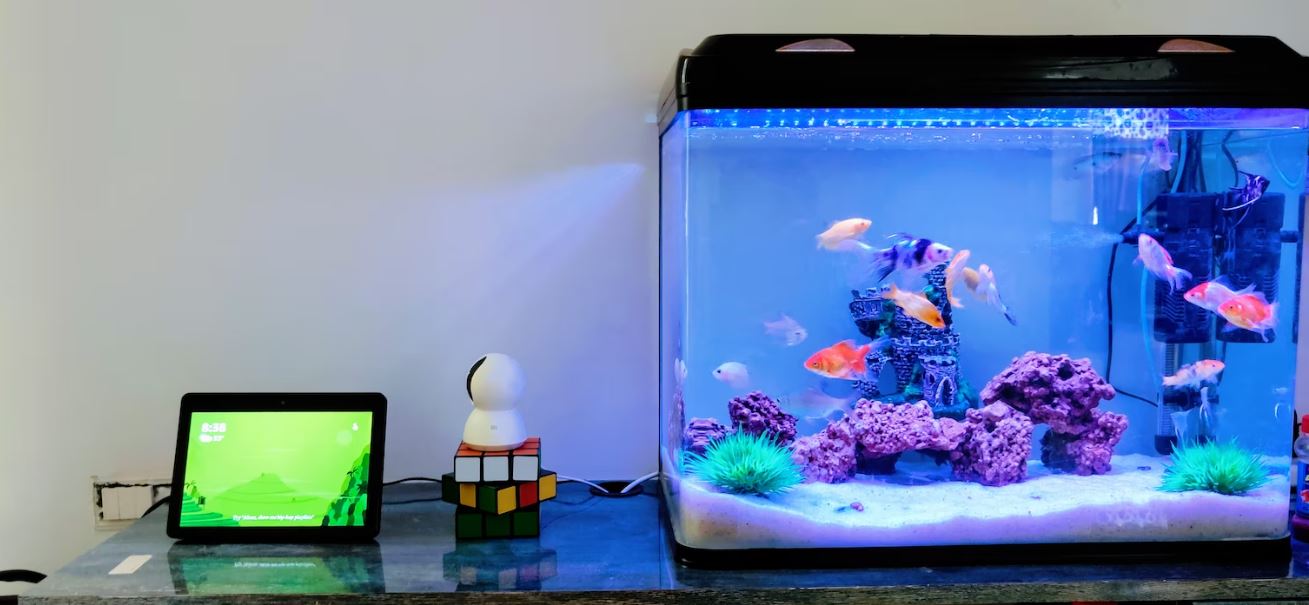One can order or purchase an aquarium in various sizes and forms to accommodate virtually any species of fish or another marine invertebrate. Aquariums for the interior vary significantly in their upkeep requirements and time commitments. All aquariums and fish tanks include living organisms, so care must be taken for their well-being. You must have a complete understanding of how to maintain a healthy aquarium and fish.
1. Aquariums With Saltwater Fish
Marine fish require a saltwater tank. If fish are to be kept alive, the water must be heavily filtered. The ideal temperature for a saltwater aquarium containing tropical fish is between 26.7 and 27.8 degrees Celsius. The popular saltwater variants include the Coral Beauty Angelfish which is a favorite among saltwater fish keepers due to its striking appearance and resilience. Depending on its natural habitat, it may have a red, orange, or yellow body with deeper blue or purple around the margins, fins, and tail. One of the most well-liked dwarf angelfishes is the flaming angelfish. Once you see one swimming in a tank, you’ll understand why they’re so sought. The fish are so named because of their bright red skin and orange midsection, which give the impression that the fish themselves are on fire. Beautiful and wildly popular, the Blue Devil Damselfish lives in seawater. Until recently, it was the second most imported fish in the world. Despite being tiny, colorful, and exquisite, they are the cheapest saltwater fish you can buy.
2. Aquariums For Freshwater Fish
Fish kept in freshwater aquariums often come from streams and rivers, but there are also warm-water freshwater aquariums. The ideal temperature range for a freshwater aquarium housing tropical fish is between 24.5 and 26.7 degrees Celsius. Mickey Mouse Platys is a live-bearing, brightly colored fish that is great for new fish keepers. Many novice fish keepers start with just a few fish because they are live-bearing. The Neon Tetra is a widespread species of fish kept in freshwater aquariums. The red and blue stripes on their bodies give these fish their distinctive look.
3. Community Aquarium
Community aquaria are fish tanks that may house multiple fish species. Plants in a community aquarium need to be hardy and can help support a wide variety of fish species worldwide. Angelfish from Brazil, swordtails from Mexico, and gouramis from Southeast Asia are all examples of species that wouldn’t ordinarily be found in the same aquarium. The point of these communities is to house fish that get along well and share the same water conditions while also using the visual and behavioral variables that each species offers. While marine aquaria aren’t typically considered community tanks, they often contain species from a wide variety of geographic regions.
4. Planted Aquarium
A planted aquarium filled with plants is a one-of-a-kind, authentic aquatic ecosystem you can set up in your own house. Aquariums with live plants and fish are called “planted”, or “natural” aquariums, and they are designed to simulate the pristine natural ecosystems of the ocean. The various advantages of these aquariums are being discovered by gardeners, educators, and seasoned aquarists. Because fish and plants work together so well, a natural aquarium is low-maintenance compared to other types of aquariums. Plants benefit from the carbon dioxide and nutrients that fish supply. Aquatic plants help maintain a pristine ecosystem by performing their form of biological filtering and adding oxygen. You can appreciate the delicate elegance of this aquarium whether you’re a novice or an experienced hobbyist of planted aquariums. In this article, we’ll show you how to transform a 20H aquarium into a lovely natural environment by adding some simple aquatic plants.
5. Fish Bowl Aquarium
A traditional fish bowl is the simplest form of an aquarium. We give the fish a bowl, fill it with water, then provide them with a fish. This could be the perfect place to dive in if you’ve never kept fish before. Fish bowls are inexpensive and can be found in various sizes, though the majority are pretty small. A fish tank lacks electrical components, including a filter, lighting, and power source. A fish bowl is just a bowl with fish in it. You may add flair to your fish bowl and make it more aesthetically pleasing for you and your fish by purchasing various aquarium pebbles, stones, and ornaments. Fish dishes need to be cleaned regularly and carefully consider their placement and size. Inquire at your neighborhood pet shop about what might work best in your aquarium.
6. Virtual Aquarium
A virtual aquarium is a piece of software that, with the help of 3D graphics, simulates an aquarium on a computer screen. While the tank’s backdrop is often static, the swimming fish are produced in real-time. Fish may be made to swim in front of and behind things on the tank bottom by mapping them in simple planes, while a simple 3D map of the overall shape of such objects can be used to generate realistic shadows cast by the light and ripples on the surface of the water. Virtual aquariums, which are frequently used as screensavers, typically feature bubbling water and other sea sounds. In addition to fish, different marine life, including jellyfish, sea turtles, seahorses, and starfish, are often available, with the amount of each species chosen by the customer.

A new study suggests that aquariums can positively affect people’s health and happiness. During the experiment, participants pulse rates and blood pressure dropped significantly, and their moods improved. Since most people do not dive, they miss out on seeing the wide variety of species that inhabit the ocean. It’s good to have an aquarium to see the marine life right inside your homes.

